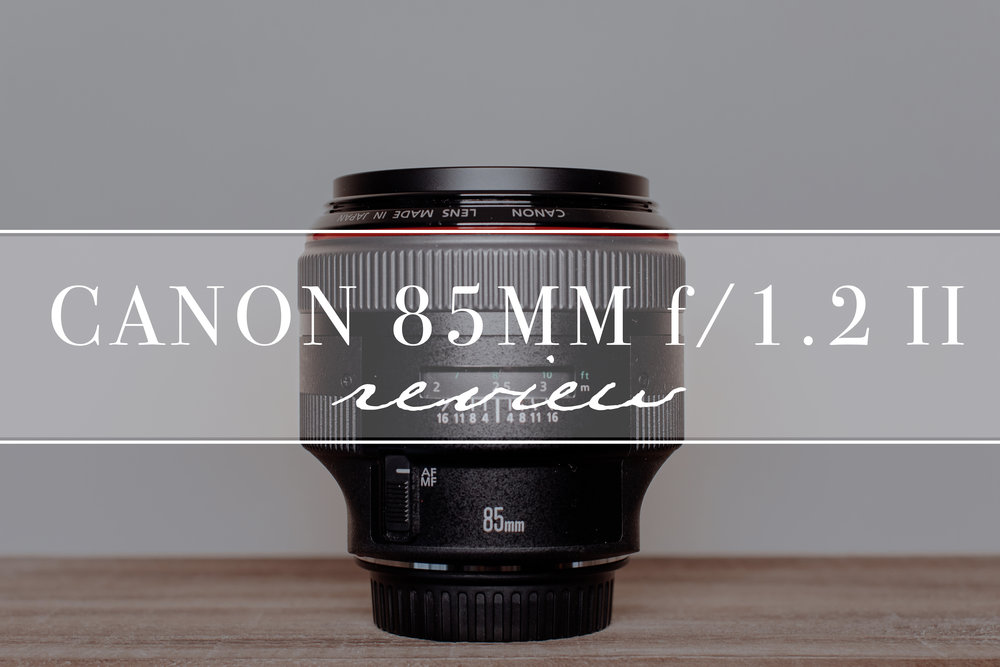
One of our favorite camera lenses, the Canon 85mm f/1.2 II is one of the few lenses we find to always be in use during weddings, engagement sessions, and an array of portrait photography.
We were impressed by the quality of the images we had seen from it, and as many other reviewers like to point out (but not like it matters), the lens itself is quite beautiful to look at. The colors when the light hits it just right is sort of hypnotic, but it’s not the sort of thing that draws photographers to actually want to buy one. Still, nothing helps make a professional photographer feel more professional than having equipment that looks good 😊
As we started to acquire better and better pro gear for our photography business, the 85mm became an obvious choice after we got our hands on it, and actually used it on some shoots…
Use the Canon 85mm f/1.2 for pristine portraits

The most obvious application of the 85mm f/1.2 lens is for portrait photography.
Let’s face it, if you are considering this prime lens at all, you are probably thinking about it can help you up your game in this department. While, like any lens, it could certainly be utilized in other ways (we have shot some landscape photos with it while traveling in Iceland, for instance) – for wedding or portrait photographers (or both!) – the 85mm provides a substantial amount of value.
Understand why we use the lenses we do
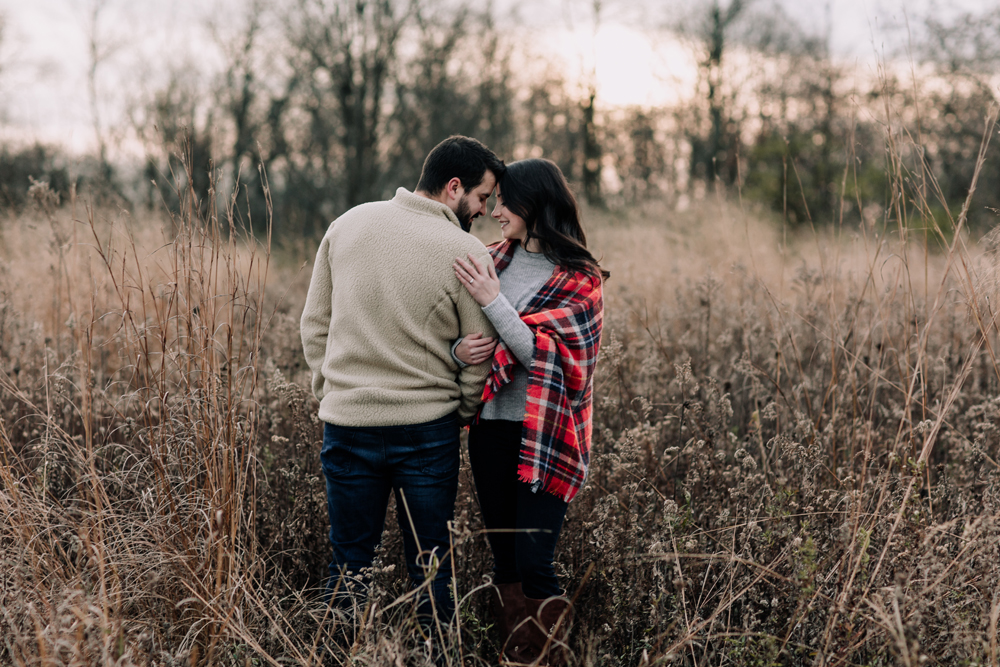
As photographers in the Lehigh Valley, surrounding regions, and even to destination venues from time to time – one thing we have found to be a common trend among the clients we have taken photos for is that they love our photographic style – leaning more towards candid/documentary type photograph as opposed to looking like forced, “stand there and do this” photography. While this may seem like extra info you don’t need, it actually is essential for understanding why we choose certain lenses over others.
You see, while some photographers may aim to have a really large collection of lenses and other equipment, or maybe just select gear seemingly at random – there is a method to the madness for us. As a photographer capturing huge events like weddings, it is invaluable to know the equipment you are using, the pros and cons, and how it will help you to capture your couple’s wedding day beautifully – and still be a reflection of the type of art work you like to produce.
While there is no doubt that becoming really proficient takes a lot of hard work, practice, and more hard work…defining your photographic style really begins with selecting the appropriate gear. Your camera body is the foundation, and lens selection is the house that is built on top. From there, you can populate this fun metaphor with plenty of décor and furniture (think: other camera gear, photo editing style, etc.) and then a family (your clients!).
So in this context, the 85mm serves us as being a powerful portrait lens. After receiving photos from our wedding, while we love all of the small details captured, pictures of our friends and family dancing, and running out of our barn reception hall to an exit of sparklers – the most memorable photos are those of our portraits. We speak from experience of having gone through this experience, and knowing what appeals to us most, and have seen this sentiment reflected in our couples, too!
There is something so intrinsically desirable to having pictures of just you + your loved one on the biggest day of your life. Many bride + groom portraits feel like little quiet escapes from the larger collection of photos that are often filled a lot of craziness (the good kind!). Of course, family portraiture also benefit from an 85mm as well (unless it is a huge family photo being taken at the shot might end up being too tight).
To cap off this section simply, the Canon 85 f/1.2 II lens is one we carefully selected to be a part of the gear we carry with us all the time. Let’s talk now more about the technical and artistic reasons why this is…
Why portraits with the Canon 85mm f/1.2 II lens are memorable
One of the main lures of the Canon 85mm f/1.2 II lens is quite simply it’s maximum aperture of f/1.2. Shooting with a wide open aperture does two main things for your photos:
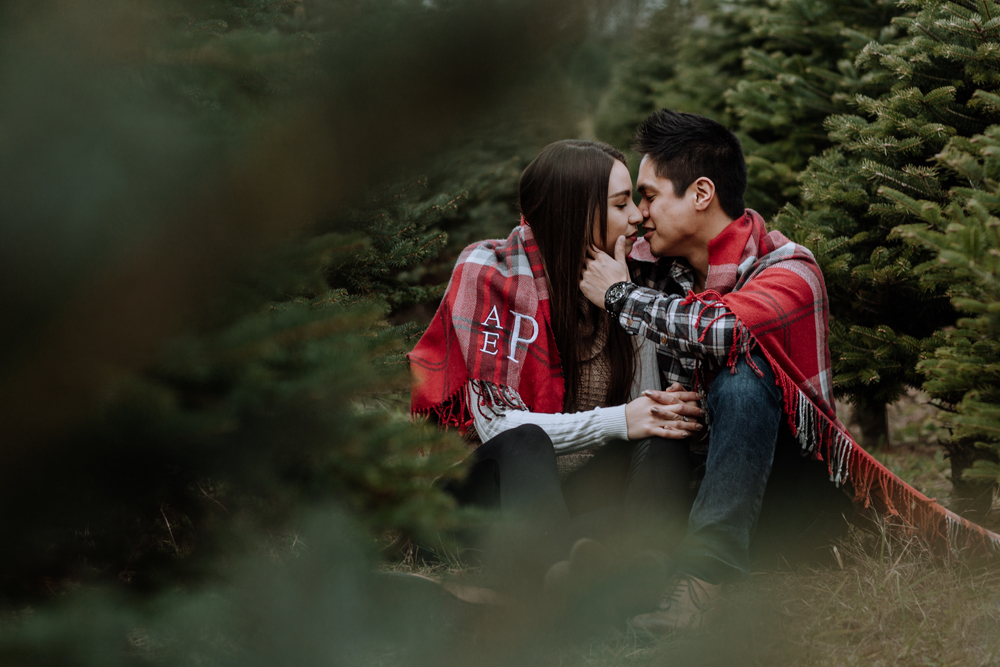
On the technical end of things, it lets more light in to the camera’s sensor. This is useful for a number of reasons, but for us in particular this enables a few simple things: shooting more naturally even into darker periods of the evening such as the end of sunset or blue hour without requiring flash to artificially fill the scene with light, and it also enables higher shutter speeds to be used while keeping the ISO down lower when shooting wide open. This is particularly useful with our style of photography, often creating portraits out of organic and candid moments that might be a little more fast paced than “regular” portrait photography. Of course, we’d be wrong to ignore that when shooting wide open at f/1.2 or 1.4 (or really anything up to 2.8), the depth of field and subsequent bokeh produced is beautiful and impossible to achieve with most other non-prime lenses. This is one of the main technical characteristics that will will cause someone to purchase an 85mm specifically as opposed to just sticking solely with a 70-200mm f/2.8 (note: we have both!).
On the artistic side, it becomes glaringly obvious why this 85mm lens is so great once you take a handful of photos with it. While talking the tech specs of camera lenses is fun and all, let’s admit, as photographers we mainly just want to see what the result looks like. Breaking this down, there are really 3 core components of the visual appearance of the outputted images that make it stand out to us when compared to many other lenses we have used: the depth of field/bokeh output, the color, the clarity.
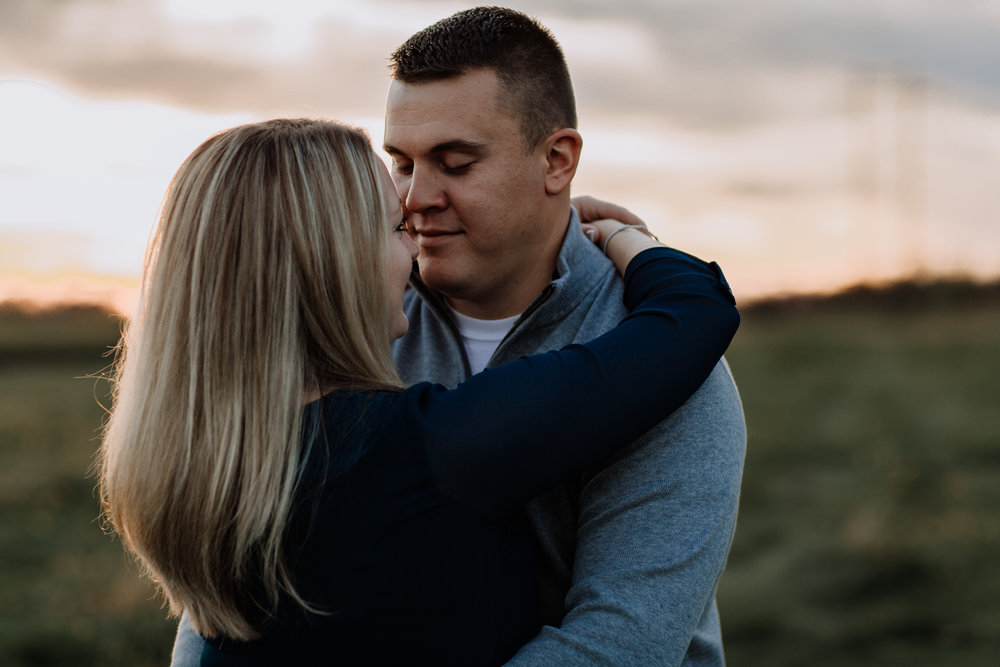
We’ve already touched on the impact of the depth of field that comes with shooting at a wide open aperture like f/1.2. It’s simply breathtaking. The separation of the subject from the background is maybe not something your couples will notice specifically, but they will notice that…this picture looks different than what we get on our iPhone. That sort of result is why this is a professional grade lens, for sure. Choosing the right light and environments (or just getting lucky sometimes) can help to showcase this even more. We especially love a good bokeh’d sunset sky behind our couples 🙂 For those who don’t know, it is the longer focal length that helps to produce this high quality compression + bokeh effect. Other longer lenses like a 135mm prime lens will output similarly beautiful results, but having used both in our workflow – the 85mm is preferable because it does not require as much distance from the shooter and the subject – which is pretty essential for us as we don’t care to yell posing directions to our couples!!
For color and clarity, we will condense these into one simple section here. While technical descriptions might be amusing for some, we will forgo this and just make a few simple statements and follow them up with some sample images we have taken.
The color quality when shooting with this 85mm lens is beautiful, in particular when attached to a quality body such as the Canon 5D Mark III and Canon 5D Mark IV respectively (both of which we use). We would expect you would have a pro level camera body if you are considering the purchase of this lens, just based on price alone (this 85mm currently sells for around $1,800). If you do not have a high quality body, you will want to consider purchasing one as your camera sensor is just as valuable as the glass you choose to take quality images.
Anyways, when shooting in Camera RAW, we have found the color and clarity (and all the “in between” fields that make up an image such as the depth of shadows, details retained in highlights, etc.) to be superior to other lenses in our kit such as the 50mm. Even in comparable lighting and posed situations, the detail retained is much superior in the 85mm. That is not to say the 50mm is bad – it is not by a long shot and is actually another staple in our standard photography bag – but if beautifully compressed, detailed, portraits are what you are after – and you are comfortable with having to take a few steps back from the couple you are working with – you will find the 85mm to likely be preferable.
More about our photography process
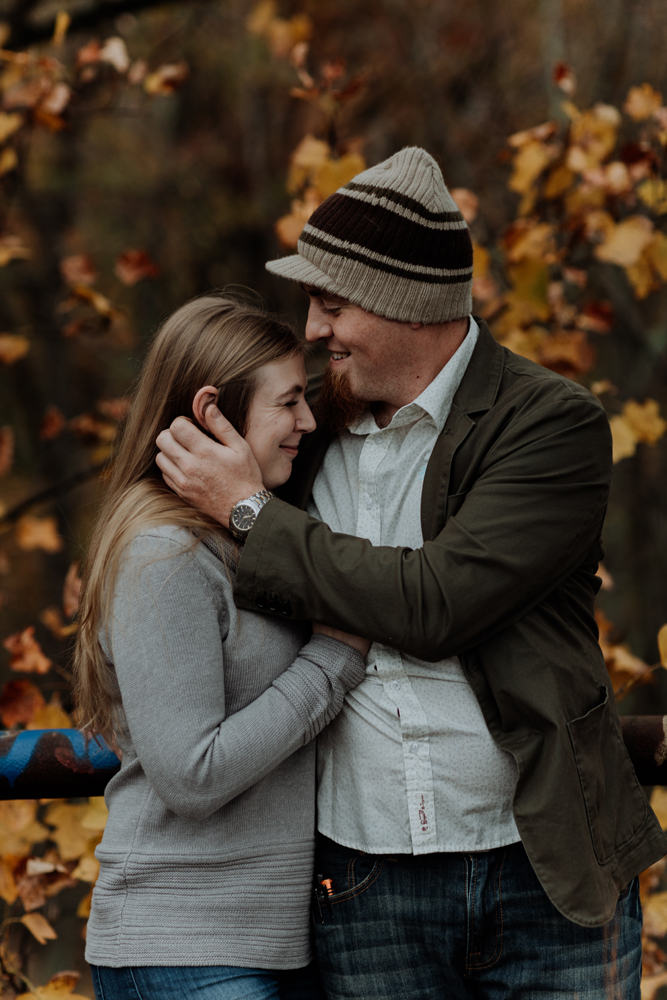
As a part of our Canon 85mm f/1.2 II lens review, we would be wrong to not include some information about our actual photo process. As you have probably noticed, we write this review from our shared perspective on photography with this lens (and others).
In general, one of us will usually be using a Canon 50mm f/1.2 II lens – as it allows one of us to be closer to our couple – which provides more intimacy between photographer + subject, which is preferable for us as we are generally soft spoken and don’t care to shout instructions for poses from 100ft. away. The second, “backup” shooter will usually use the 85mm f/1.2 II so as to be able to take a step back – or shoot from a different angle the same scene and pose. This is beneficial for us as we are able to get a wider range of shots, with unique characteristics due to different lenses and bodies, as well as different angles and artistic perspectives.
No doubt, there is easily more flexibility with picking lenses while shooting as a photography team. As a solo photographer, your lens choice may be more limited – or you may want to consider carrying two camera bodies affixed with different lenses as we sometimes do on our own with the Holdfast Moneymaker. In this context of being the lone shooter, an 85mm is still an ideal lens choice. We do occasionally shoot small projects on our own, and recently Jes’ captured a lifestyle portrait session almost strictly with this lens.
Due to the constant use of different lenses, we are exposed heavily to the differences in image quality in post processing of the images in Lightroom. This is how we have been able to acknowledge the differences in image quality, color, contrast, clarity, etc. of the 85mm in comparison with the 50mm and other non-prime lenses.
The last thing worth noting is that, while the Canon 85mm f/1.2 II lens is a staple in our camera bag, we do also use several other lenses commonly – especially on the wedding day or during more adventurous engagement sessions. Every lens we have chosen to use serves as a fundamental tool for us, and we aim to keep our camera bag light by only carrying a handful to any session.
Last thoughts on the Canon 85mm f/1.2 II lens
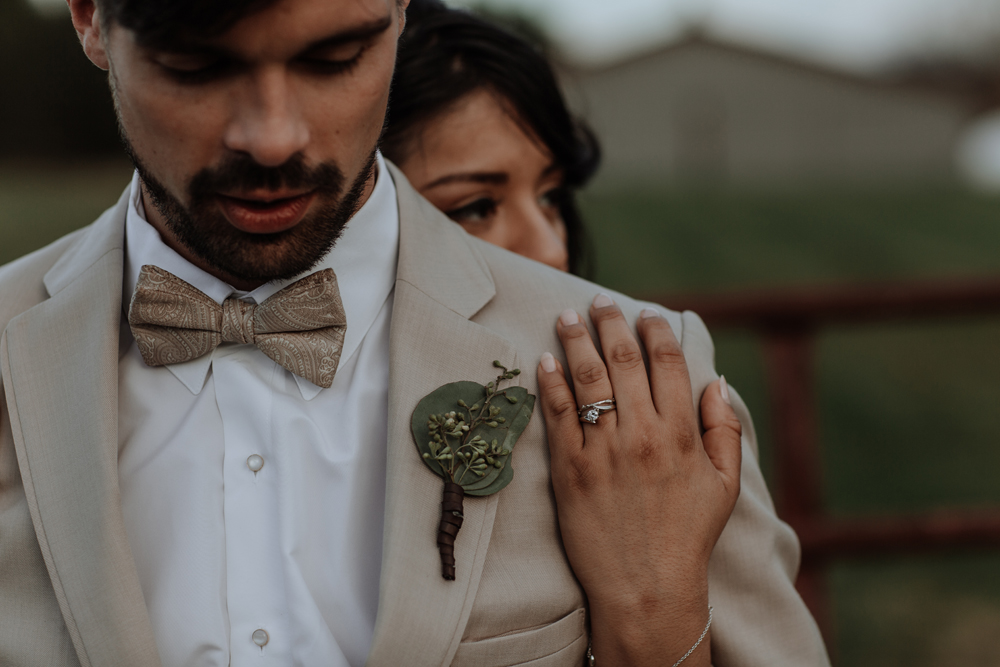
If you are searching for a high quality portrait lens, and in particular are looking for a lens that specializes in this type of photography (so…a prime lens), the Canon 85mm f/1.2 II lens is a perfect choice. The glass quality and focal length produces beautiful compression, a depth of field to die for when actually shooting wide open, and excellent details to be captured by your camera sensor when properly exposing your images. The quality becomes apparent pretty quickly after using it in the field.
The only downside that we have noticed is that it can be slow to focus, making it difficult to get some crisp and clear images when shooting rapidly – something we often do as we aim to capture those candid, in-the-moment types of shots. This is especially noticeable when shooting wide open at f/1.2. This is something we have generally accepted for our shoots, and we have learned that when using this lens, it is important to pick your shots and keep a steady hand. In general, we experience some softness in images, but not usually blurry or unusual images – which jives just fine with our photography style. Additionally, some people have mentioned the weight of the lens – yes, it is heavier than a 50mm – but this is to be expected from any prime lens of a larger focal length. We have never had issue shooting for prolonged periods of time with it. The only lens to grant us this as a potential problems in the 70-200mm.
In the market for a Canon 85mm f/1.2 II lens? Consider purchasing through our Amazon links. We make a small commission from each purchase. If you have found this review to be useful, using these links is a simple way to give back and enable us to continue producing educational content like this. If you have any questions about this 85mm lens that are not answered in the review above, feel free to leave a comment below!